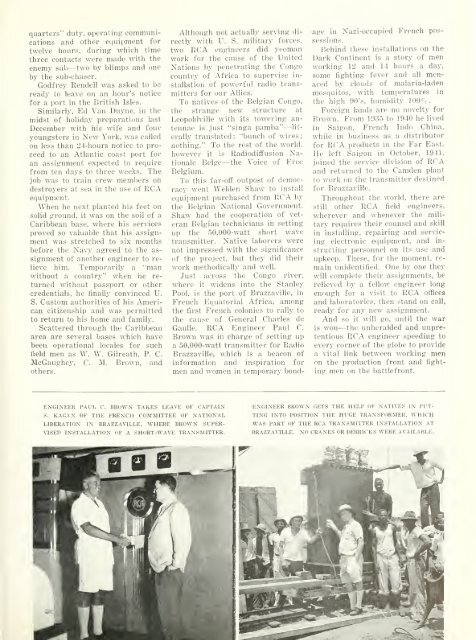Radio Age - 1944, January - 36 Pages, 3.3 MB ... - VacuumTubeEra
Radio Age - 1944, January - 36 Pages, 3.3 MB ... - VacuumTubeEra
Radio Age - 1944, January - 36 Pages, 3.3 MB ... - VacuumTubeEra
Create successful ePaper yourself
Turn your PDF publications into a flip-book with our unique Google optimized e-Paper software.
quarters" duty, operating communications<br />
and other equipment for<br />
twelve hours, during which time<br />
three contacts were made with the<br />
enemy sub—two by blimps and one<br />
by the sub-chaser.<br />
Godfrey Rendell was asked to be<br />
ready to leave on an hour's notice<br />
for a port in the British Isles.<br />
Similarly, Ed Van Duyne. in the<br />
midst of holiday preparations last<br />
December with his wife and four<br />
youngsters in New York, was called<br />
on less than 24-hours notice to proceed<br />
to an Atlantic coast port for<br />
an assignment expected to require<br />
from ten days to three weeks. The<br />
job was to train crew members on<br />
destroyers at sea in the use of RCA<br />
equipment.<br />
When he next planted his feet on<br />
solid ground, it was on the soil of a<br />
Caribbean base, where his services<br />
proved so valuable that his assignment<br />
was stretched to six months<br />
before the Navy agreed to the assignment<br />
of another engineer to relieve<br />
him. Temporarily a "man<br />
without a country" when he returned<br />
without passport or other<br />
credentials, he finally convinced U.<br />
S. Custom authorities of his American<br />
citizenship and was permitted<br />
to return to his home and family.<br />
Scattered through the Caribbean<br />
area are several bases which have<br />
been operational locales for such<br />
field men as W. W. Gilreath, P. C.<br />
McGaughey, C. M. Brown, and<br />
others.<br />
Although not actually serving directly<br />
with U. S. military forces,<br />
two RCA engineers did yeoman<br />
work for the cause of the United<br />
Nations by penetrating the Congo<br />
country of Africa to supervise installation<br />
of powerful radio transmitters<br />
for our Allies.<br />
To natives of the Belgian Congo,<br />
the strange new structure at<br />
Leopoldville with its towering antennae<br />
is just "singa pamba"—literally<br />
tran.slated : "bunch of wires<br />
nothing." To the rest of the world,<br />
however it is <strong>Radio</strong>diflfusion National<br />
Beige—the Voice of Free<br />
Belgium.<br />
To this far-off outpost of democracy<br />
went Welden Shaw to install<br />
equipment purchased from RCA by<br />
the Belgian National Government.<br />
Shaw had the cooperation of veteran<br />
Belgian technicians in setting<br />
up the 50,000-watt short wave<br />
transmitter. Native laborers were<br />
not impressed with the significance<br />
of the project, but they did their<br />
work methodically and well.<br />
Just across the Congo river,<br />
where it widens into the Stanley<br />
Pool, is the port of Brazzaville, in<br />
French Equatorial Africa, among<br />
the first French colonies to rally to<br />
the cause of General Charles de<br />
Gaulle. RCA Engineer Paul C.<br />
Brown was in charge of setting up<br />
a 50,000-watt transmitter for <strong>Radio</strong><br />
Brazzaville, which is a beacon of<br />
information and inspiration for<br />
men and women in temporary bondage<br />
in Nazi-occupied French possessions.<br />
Behind these installations on the<br />
Dark Continent is a story of men<br />
working 12 and 14 hours a day,<br />
some fighting fever and all menaced<br />
by clouds of malaria-laden<br />
mosquitos, with temperatures in<br />
the high 90's, humidity 100^,.<br />
Foreign lands are no novelty for<br />
Brown. From 1935 to 1940 he lived<br />
in Saigon, French Indo China,<br />
while in business as a distributor<br />
for RCA products in the Far East.<br />
He left Saigon in October, 1941,<br />
joined the service division of RCA<br />
and returned to the Camden plant<br />
to work on the transmitter destined<br />
for Brazzaville.<br />
Throughout the world, there are<br />
still other RCA field engineers,<br />
wherever and whenever the military<br />
requires their counsel and skill<br />
in installing, repairing and servicing<br />
electronic equipment, and instructing<br />
personnel on its use and<br />
upkeep. These, for the moment, remain<br />
unidentified. One by one they<br />
will complete their assignments, be<br />
relieved by a fellow engineer long<br />
enough for a visit to RCA offices<br />
and laboratories, then stand on call,<br />
ready for any new assignment.<br />
And so it will go, until the war<br />
is won—the unheralded and unpretentious<br />
RCA engineer speeding to<br />
every corner of the globe to provide<br />
a vital link between working men<br />
on the production front and fighting<br />
men on the battlefront.<br />
ENGINEER PAUL C. BROWN TAKES LEAVE OF CAPTAIN<br />
S. KAGAN OF THE FRENCH COMMITTEE OF NATIONAL<br />
LIBERATION IN BRAZZAVILLE, WHERE BROWN SUPER-<br />
VISED INSTALLATION OF A SHORT-WAVE TRANSMITTER.<br />
ENGINEER BROWN GETS THE HELP OF NATIVES IN PUT-<br />
TING INTO POSITION THE HUGE TRANSFORMER, WHICH<br />
WAS PART OF THE RCA TRANSMITTER INSTALLATION AT<br />
BRAZZAVILLE. NO CRANES OR DERRICKS WERE AVAILABLE.
















